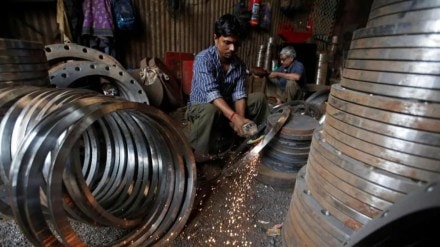By HD Kumaraswamy
India’s industrial landscape is undergoing a transformation, propelled by the ethos of Aatmanirbharta, a vision of self-reliance positioning our nation as a global leader in innovation and manufacturing. I have had the privilege of steering the vital ministry of heavy industries (MHI) under the leadership of Prime Minister Narendra Modi. His clarion call for Aatmanirbhar Bharat and Viksit Bharat by 2047 guides our endeavours to foster a self-reliant industrial ecosystem. At the launch of the Make in India initiative in 2014, he envisioned, “A self-reliant India will not only meet its own needs but also lead the world in innovation and manufacturing by 2047.” This vision drives the MHI to champion self-reliance.
A New Bharat is taking shape—vibrant, sustainable, and poised to lead in innovation and green technology. This transformation is driven by a commitment to reimagine India’s industrial landscape, with the automobile sector at the forefront. The MHI is building an ecosystem that is aligned with a self-reliant and developed India, ensuring growth with inclusivity, innovation, and sustainability.
The Prime Minister envisions an India that is self-sufficient, technologically advanced, and a beacon of industrial excellence. Achieving net-zero emissions by 2070 is central to this vision, underscoring the urgency of transitioning to cleaner technologies. At the MHI, we are ensuring the automobile sector becomes a key driver in this journey.
Key initiatives
Production-linked incentive (PLI) scheme for automobiles and auto components: Launched with an outlay of Rs 25,938 crore for FY23 to FY27, it incentivises domestic manufacturing of advanced automotive technology (AAT) products. Investments of Rs 29,576 crore till March have already been made against a target of Rs 42,500 crore, with a cumulative sales increase of Rs 2,31,500 crore expected over five years. As of April, six champion original equipment manufacturers and seven component champions have begun manufacturing AAT products with minimum 50% domestic value addition.
PLI scheme for advanced chemistry cell (ACC) battery manufacturing: With an allocation of Rs 18,100 crore, it strengthens India’s position in the global electric vehicle market (EV) by incentivising advanced battery production and reducing import reliance. Investments from leading manufacturers are enabling high-quality, cost-effective batteries powering two-wheelers, three-wheelers, and buses.
Faster Adoption and Manufacturing of Electric Vehicles (FAME): FAME I (2015) and FAME II (2019) have been crucial in boosting EV adoption and charging infrastructure. These schemes expanded EV penetration and encouraged domestic production, laying the foundation for a robust EV ecosystem.
PM Electric Drive Revolution in Innovative Vehicle Enhancement (PM E-DRIVE): Launched in September 2024, this landmark scheme comprehensively supports the EV ecosystem. It targets electric two- and three-wheelers, e-buses,
e-ambulances, and e-trucks, while modernising testing and certification infrastructure. Sales of electric two-wheelers surged from 1,565 units in FY15 to 11.50 lakh in FY25, and electric three-wheelers (L5) from 19 units to 1.59 lakh units during the same period.
E-bus deployment and charging infrastructure: The MHI has committed to deploying 10,900 e-buses in Delhi, Bengaluru, Hyderabad, Surat, and Ahmedabad, revolutionising urban transportation and reducing pollution. Additionally, Rs 2,000 crore has been allocated for installing 22,100 fast chargers for e-4Ws, 1,800 for e-buses, and 48,400 for e-2W/3Ws in cities and highways.
SMEPCI: The Scheme to Promote Manufacturing of Electric Passenger Cars in India requires applicants to invest a minimum of Rs 4,150 crore, further boosting the EV supply chain through innovation and skilling.
India is now the third-largest automobile market, overtaking Japan. EV sales rose from 2,343 units in FY15 to 19.67 lakh units in FY25. Guided by the Prime Minister’s vision, the EV revolution is accelerating, driven by transformative MHI initiatives and industry collaboration. NITI Aayog projects that by 2030, 70% of commercial cars, 30% of private cars, 40% of buses, and 80% of two- and three-wheelers sold in India will be electric.
Capital goods sector growth: MHI’s Scheme for Enhancement of Competitiveness in the Indian Capital Goods Sector, launched in 2014 and expanded in 2022 with Rs 1,207 crore, empowers micro, small, and medium enterprises through Samarth centres and advanced skilling programmes. India’s heavy electrical industries have grown from Rs 1.59 lakh crore in FY15 to Rs 3.84 lakh crore in FY25. Machine tools, printing machinery, textile machinery, and heavy construction equipment have all recorded threefold growth over the decade.
Rare earth magnets: Recognising their strategic importance for EV motors, wind turbines, and electronics, the MHI is building indigenous capacity in magnet manufacturing through R&D investments and strategic partnerships, reducing import dependence.
Looking ahead
The MHI is committed to fulfilling the PM’s vision of Aatmanirbhar Bharat and Viksit Bharat by 2047. By fostering public-private partnerships and leveraging accelerators like the CAMRAS (Centre for Advanced Manufacturing of Robotics and Autonomous Systems) programme at ARTPARK, Indian Institute of Science, Bengaluru, India aims to lead in green technology, defence, space exploration, and industrial innovation.
Through these initiatives, we are reducing fossil fuel dependence, enhancing energy security, and positioning India as a global leader in sustainable transportation and industrial excellence.
The writer is union minister of heavy industries and steel.
Disclaimer: Views expressed are personal and do not reflect the official position or policy of FinancialExpress.com. Reproducing this content without permission is prohibited.
